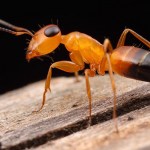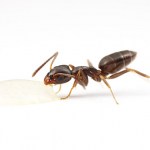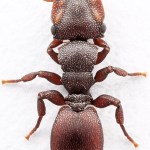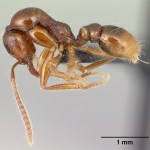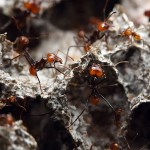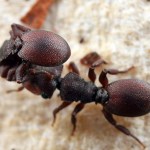ants
New this week at alexanderwild.com we have photographs of the Savanna Strobe Ant Opisthopsis haddoni. These delightfully perky insects inhabit open environments in northern Australia and are one of my favorite ants.
Opisthopsis has excellent vision. The location of the compound eyes atop the head allows it to spot a photographer approaching from any direction and take appropriate evasive action. This wasn't the easiest ant to shoot.
The peculiarly erratic style of walking is also not conducive to photography. The common name "strobe ant" refers to this ant's unpredictable little fits and…
An amazing photo posted this week at Antweb shows a developing male Cerapachys ant inside the silken cocoon:
(Image by Erin Prado)
How did they catch this footage of an ANTi-pesticide protest? Here's a peek behind the scenes.
Take a photograph, of course:
Tapinoma sessile, the odorous house ant
photo details:
Canon EOS 50D camera
Canon MP-E 65mm 1-5x macro lens
ISO 100, f/13, 1/250sec
Blog posts are long, thin things.
One could, for example, use a blog to post a high-resolution map of Chile. Or a single strand of spagetti. Any image up to 500 pixels wide, for as long as it goes. In that vein, here's a Cephalotes varians turtle ant:
Just wait until I find a stick insect.
Yesterday, Antweb posted its first images of Anomalomyrma workers, and I've been staring at them ever since.
This is a strange ant indeed, a member of the ancient subfamily Leptanillinae that is potentially a sister lineage to the remaining extant ants. It's ostensibly a subterranean predator in the forests of tropical Asia, but beyond that little is known. The number of times Anomalomyrma has been collected can probably be counted on my fingers.
Here's a pic:
Call me crazy, but the shape of this thing puts me in mind of another ant oddity: Martialis heureka:
Martialis was discovered in…
The U.K.-based film company Ammonite has been blogging their ant-filming experiences in Costa Rica and Spain. The glamor of making nature documentaries apparently includes skin parasites and volcano-related travel limbo.
The journal Myrmecological News has a trio of new articles, including descriptions of two new myrmicine species.
Ted MacRae thinks ant taxonomy is entirely too complicated and proposes an alternative.
Ant developmental biologist Ehab Abouheif is featured in a short but excellent documentary (French language). (h/t Archetype).
Marvel's Ant-Man inches closer to the big screen…
I apologize for the slow blogging this weekend. We took a little road trip up to beautiful Madison, Wisconsin and were too busy with bratwurst, cheese, beer, and roller derby to bother with the internet.
Atta cephalotes in the fungus garden
The University of Wisconsin is home to Cameron Currie, whose lab is at the cutting edge of insect-fungus-microbe evolutionary biology. Cameron is one of the people who first realized that the classic ant/fungus mutualism was more complex than just the insect and the fungus, involving all sorts of microbes, including some that live on the ants' exoskeleton…
You're in luck! Antweb has added an excellent blog to handle submitted questions. The answer squad is headed by myrmecologists at the Chicago Field Museum, and so far they've fielded queries about what ants do in winter, whether fire ants will reach the northern U.S., the difference between ants and termites, and several others.
Send your questions to askantweb@calacademy.org.
From "Life in the Undergrowth", perhaps the finest insect documentary ever made, a scene featuring Australia's intertidal ants:
A few years back I traveled through northern Queensland with myrmecologists Phil Ward and Gary Alpert. Having heard about the aquatic abilities of these ants, we searched for them in a mangrove forest just outside the Cairns airport while waiting for our flight. After a bit of looking, Phil found a foraging trail of large black ants going up a mangrove trunk.
We dropped a few into the water below, and sure enough- swimming ants! It's a remarkable behavior.
Today, it's the New York Times. Consider this Q & A:
Q. Can the tiny ants that visit me every spring hop like a flea? Sometimes I look down and suddenly there one is, working its way across my anatomy.
A. It is possible. Several of the estimated 10,000 to 14,000 identified species of ant are capable of hopping or leaping, including at least one with a potentially fatal bite...
The jack jumper ant, Myrmecia pilosula, which is native to Australia, jumps when agitated. Its highly toxic venom allows it to prey upon insects as large as wasps.
Jerdon's jumping ant, an Indian species that has…
Strumigenys rogeri in the leaf litter
In 1982, a small journal called The Coleopterists Bulletin carried a two page note by beetle expert Terry Erwin that increased- by an order of magnitude- the estimated number of species on the planet. Erwin crunched some back-of-the-napkin numbers based on the tree specificity of arthropods he'd collected in Panamanian tree canopies and the richness of tropical tree species worldwide to surmise that the earth should hold 30 million species. An impressive bump from the 1 to 2 million that was the going estimate.
Later research on canopy arthropods (For…
If ants were to drop acid I'm not sure what they'd experience. But this entrancing short film by Jörg Brönnimann is as good a guess as any:
ant-views from Jörg Brönnimann on Vimeo.
The downside to a celebrated and prolific scientific career is that you generate enough of a paper trail for something you concluded, somewhere, to be erroneous.
I happened on an amusing example this week while photographing the Caribbean turtle ants I blogged about earlier. Like most of the world's 12,000 or so ant species, not much is known about the biology of Cephalotes varians. However, famed myrmecologist E. O. Wilson maintained a few lab colonies in the 1970's and detailed his hours of meticulous observations in a paper entitled "A Social Ethogram of the Neotropical Arboreal Ant…
I would be remiss in my duties as an ant blogger to not pass this on from NCBI ROFL:
Transcultural sexology: formicophilia*, a newly named paraphilia in a young Buddhist male.
*The sexual interest in being crawled upon or nibbled by small insects, such as ants
Abstract: Children whose species-specific, juvenile sexual rehearsal play is thwarted or traumatized are at risk for developing a compensatory paraphilia. The case of a Buddhist male exemplifies the cross-cultural application of this principle. His syndrome, formicophilia, was endogenously generated without reference to or influence by…
What was that inexplicable bit of chitin hiding away in a hole in a twig?
This photo should help:
It's the heavily sclerotized head shield of a Cephalotes varians turtle ant. Ants in this mostly Neotropical genus inhabit pre-existing cavities in trees and branches, a limiting resource that spurs intense competition among colonies of various tree-dwelling species. Workers come in two size classes: small and relatively lithe, and tank-like with a dinner plate for a head.
Turtle ants aren't fighters. Rather, they're all about defense. If a colony gets hold of an old beetle burrow, the heavily…
A few days ago I posted a photo of a Prenolepis ant queen. It's a decent photo, in focus and properly exposed. But probably not anything I'd print out and hang on the wall.
Check out the monochrome version above, though (click on it to enlarge). I don't often put my images through such severe levels adjustments, but this one works rather well. I prefer it to the original.
Wasmannia auropunctata - little fire ants Buenos Aires, Argentina
One of the world's worst invaders, the little fire ants have spread from the new world tropics to warmer regions around the globe, becoming especially problematic on oceanic islands. The ants above, though, are from an innocuous native population in northern Argentina. They arrived at a cookie bait at the Costanera Sur reserve, barely noticeable specks of orange just over a millimeter long.
Wasmannia has a painful sting for such a small insect, and the ants do this annoying thing where they'll wander around on your body for an…
If you've been following the Taxonomy Fail and subsequent Myrmecology Win, you'll know that the real Fail was my own. That blurry mash of legs and cuticle is indeed an ant, and I missed it.
That I failed to discern an ant in the original image doesn't bother me. After all, the photo was the equivalent of an amber inkblot, with key bits out of focus, and the paper itself provided no support for the identification. I stand by my comments about the burden of proof lying with the authors- the paper did not adequately justify its conclusions. Partly, this is less the fault of the authors than the…
Well. Raising a holy hullabaloo on the internet pays dividends. Vincent Perrichot, one of the authors on the contested PNAS paper, has sent along another aspect of the mystery fossil:
Having trouble? I've arranged a Formica specimen to model the pose:
In the comments below, Vincent provides his perspective:
Well, sounds that the ant nature of our fossil is getting much controversy here! I understand that the photograph provided in our paper is not very clear, so I'd like to clarify things and try to convince everyone. First of all the photograph you are commenting on was published…
